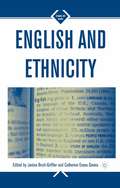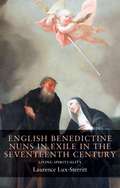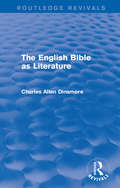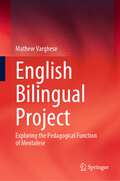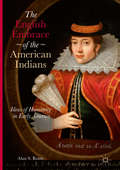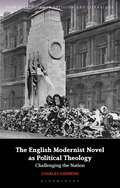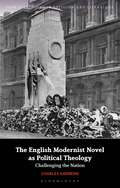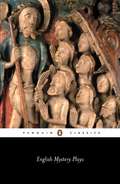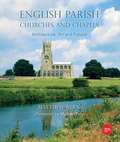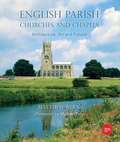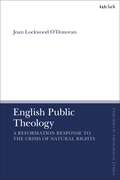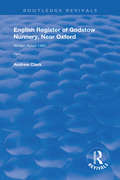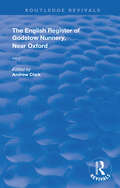- Table View
- List View
English and Ethnicity (Signs of Race)
by J. Brutt-Griffler C. Evans Davies Catherine Evans DaviesThis volume examines the complex interaction between the English language and the construction of ethnicity in the global English-speaking world. The essays demonstrate that the constructs of both English and ethnicity are contested sites of identity formation.
English Benedictine nuns in exile in the seventeenth century: Living spirituality (Seventeenth- And Eighteenth-century Studies)
by Laurence Lux-SterrittProvides the first detailed and interdisciplinary analysis of the English Benedictine communities in exile during the seventeenth century, looking at their lived experiences, emotions and senses in religious life.
English Benedictine nuns in exile in the seventeenth century: Living spirituality (Seventeenth- And Eighteenth-century Studies)
by Laurence Lux-SterrittThis study of English Benedictine nuns is based upon a wide variety of original manuscripts, including chronicles, death notices, clerical instructions, texts of spiritual guidance, but also the nuns' own collections of notes. It highlights the tensions between the contemplative ideal and the nuns' personal experiences, illustrating the tensions between theory and practice in the ideal of being dead to the world. It shows how Benedictine convents were both cut-off and enclosed yet very much in touch with the religious and political developments at home, but also proposes a different approach to the history of nuns, with a study of emotions and the senses in the cloister, delving into the textual analysis of the nuns' personal and communal documents to explore aspect of a lived spirituality, when the body which so often hindered the spirit, at times enabled spiritual experience.
The English Bible as Literature (Routledge Revivals)
by Charles Allen DinsmoreThe religious associations surrounding the Bible make it difficult for the general reader to appreciate, in its full purity, the value which the Scriptures bear as literature, and as an epic in no way inferior, in cultural worth, to the greatest works of Greece and Rome. Dealing as it does with elementary passions and principles, the English Bible is, in the author’s view, the greatest book of all the ages. This book, first published in 1931, will be of interest to students of literature and religious studies.
The English Bible as Literature (Routledge Revivals)
by Charles Allen DinsmoreThe religious associations surrounding the Bible make it difficult for the general reader to appreciate, in its full purity, the value which the Scriptures bear as literature, and as an epic in no way inferior, in cultural worth, to the greatest works of Greece and Rome. Dealing as it does with elementary passions and principles, the English Bible is, in the author’s view, the greatest book of all the ages. This book, first published in 1931, will be of interest to students of literature and religious studies.
English Bilingual Project: Exploring the Pedagogical Function of Mentalese
by Mathew VargheseToday, English is the global lingua franca and competent English communication skills should be one of the rights of all educated individuals irrespective of any socio-cultural limits. By introducing a new method, this book focuses on helping any learner to get sufficient communication skills in English as much as in the native language. This method helps one to avoid translating from mother tongue to English. And by using the method of thinking in English, one could acquire the required English bilingual skills naturally. The method is founded on the philosophical idea of mentalese—mind language as the base language of thinking available for humans for constructing thoughts. The proposed English Bilingual Project (EBP) helps one to transfer thoughts from a structureless mentalese to the grammatical structure of any language English/Japanese/Chinese. The method described in this book works in two ways: one it helps one to intuitively understand the working of mentalese; the other is by practicing think in English with the mentalese, one could generate the bilingual brain. The main procedure for transferring thoughts from the mentalese to English is through writing one’s thoughts. This helps one to think effectively in English like one’s own mother tongue. This method works as a prime requirement model for one to generate multilingual skills. The book resourced the idea of mentalese from the classical philosophy, reflects it with the modern generative theories, links it with the studies in neuro-linguistic studies on bilingualism and the bilingual brain.
English Cathedral Music and Liturgy in the Twentieth Century
by Martin ThomasThis book examines the stylistic development of English cathedral music during a period of liturgical upheaval, looking at the attitudes of cathedral clergy, liturgists, composers, leading church music figures and organisations to music and liturgy. Arguments that were advanced for retaining an archaic style in cathedral music are considered, including the linking of musical style with liturgical language, the recommending of a subservient role for music in the liturgy, and the development of a language of fittingness to describe church music. The roles of the RSCM and other influential bodies are explored. Martin Thomas draws on many sources: the libraries and archives of English cathedrals; contemporary press coverage and the records of church music bodies; publishing practices; secondary literature; and the music itself. Concluding that an arresting of development in English cathedral music has prevented appropriate influences from secular music being felt, Thomas contrasts this with how cathedrals have often successfully and dynamically engaged with the world of the visual arts, particularly in painting and sculpture. Presenting implications for all denominations and for patronage of the arts by churches, and the place of musical aesthetics in the planning of liturgy, this book offers an important resource for music, theology, liturgy students and ministry teams worldwide.
English Cathedral Music and Liturgy in the Twentieth Century
by Martin ThomasThis book examines the stylistic development of English cathedral music during a period of liturgical upheaval, looking at the attitudes of cathedral clergy, liturgists, composers, leading church music figures and organisations to music and liturgy. Arguments that were advanced for retaining an archaic style in cathedral music are considered, including the linking of musical style with liturgical language, the recommending of a subservient role for music in the liturgy, and the development of a language of fittingness to describe church music. The roles of the RSCM and other influential bodies are explored. Martin Thomas draws on many sources: the libraries and archives of English cathedrals; contemporary press coverage and the records of church music bodies; publishing practices; secondary literature; and the music itself. Concluding that an arresting of development in English cathedral music has prevented appropriate influences from secular music being felt, Thomas contrasts this with how cathedrals have often successfully and dynamically engaged with the world of the visual arts, particularly in painting and sculpture. Presenting implications for all denominations and for patronage of the arts by churches, and the place of musical aesthetics in the planning of liturgy, this book offers an important resource for music, theology, liturgy students and ministry teams worldwide.
English Catholic Historians and the English Reformation, 1585-1954
by John VidmarFor almost 400 years, Roman Catholics have been writing about the English Reformation, but their contributions have been largely ignored by the scholarly world and the reading public. Thus the myths of corrupt monasteries, a 'Bloody' Mary, and a 'Good' Queen Bess have established themselves in the popular mind. John Vidmar re-examines this literature systematically from the time of the Reformation itself, to the early 1950s, when Philip Hughes produced his monumental Reformation in England.
The English Deists: Studies in Early Enlightenment (The Enlightenment World)
by Wayne HudsonInterprets the works of an important group of writers known as 'the English deists'. This title argues that this interpretation reads Romantic conceptions of religious identity into a period in which it was lacking. It contextualizes these writers within the early Enlightenment, which was multivocal, plural and in search of self definition.
The English Deists: Studies in Early Enlightenment (The Enlightenment World #7)
by Wayne HudsonInterprets the works of an important group of writers known as 'the English deists'. This title argues that this interpretation reads Romantic conceptions of religious identity into a period in which it was lacking. It contextualizes these writers within the early Enlightenment, which was multivocal, plural and in search of self definition.
The English Embrace of the American Indians: Ideas of Humanity in Early America
by Alan S. RomeThis book makes a wide, conceptual challenge to the theory that the English of the colonial period thought of Native Americans as irrational and subhuman, dismissing any intimations to the contrary as ideology or propaganda. It makes a controversial intervention by demonstrating that the true tragedy of colonial relations was precisely the genuineness of benevolence, and not its cynical exploitation or subordination to other ends that was often the compelling force behind conflict and suffering. It was because the English genuinely believed that the Indians were their equals in body and mind that they fatally tried to embrace them. From an intellectual exploration of the abstract ideas of human rights in colonial America and the grounded realities of the politics that existed there to a narrative of how these ideas played out in relations between the two peoples in the early years of the colony, this book challenges and subverts current understanding of English colonial politics and religion.
The English Embrace of the American Indians: Ideas of Humanity in Early America
by Alan S. RomeThis book makes a wide, conceptual challenge to the theory that the English of the colonial period thought of Native Americans as irrational and subhuman, dismissing any intimations to the contrary as ideology or propaganda. It makes a controversial intervention by demonstrating that the true tragedy of colonial relations was precisely the genuineness of benevolence, and not its cynical exploitation or subordination to other ends that was often the compelling force behind conflict and suffering. It was because the English genuinely believed that the Indians were their equals in body and mind that they fatally tried to embrace them. From an intellectual exploration of the abstract ideas of human rights in colonial America and the grounded realities of the politics that existed there to a narrative of how these ideas played out in relations between the two peoples in the early years of the colony, this book challenges and subverts current understanding of English colonial politics and religion.
English Literature, Theology and the Curriculum: English Literature, Theology And The Curriculum (Theology in Dialogue)
by Liam GearonThe "Theology in Dialogue" Series explores the relationship between theology and different, secular academic disciplines which appear within the degree programs of colleges and universities. Each volume begins with a chapter and a reply, providing a thoughtful justification for the interaction of theology and the particular subject. This is followed by a theoretical analysis of this interaction, and a range of case studies illustrating the situation in the classroom. "English Literature, Theology and the Curriculum" explores the nature and authority of religious writings and their influence on secular literature. What makes it distinctive is the manner in which it investigates the textual dynamic between the two disciplines by combining both theory and case study in a single collection of writings. It discusses interdisciplinary dialogue, offers case studies on literature and theology from Anglo-Saxon verse to the twentieth-century novel, and looks at curriculum considerations. The eminence and breadth of the contributors is outstanding.Praise for English Literature, Theology and the Curriculum:"[A] superbly rich collection...as valuable to those involved in literary studies as to theologians. It breathes life and real engagement." --Times Educational Supplement "Fascinating and scholarly collection...This is an excellent book. Though some of the chapters are better than others, none is a dud. Its contributors and editor are to be congratulated." --Journal of Beliefs and Values "These substantial essays deserve more extensive comment than a brief review permits...Liam Gearon's chapter prompted this reviewer to embark on a reading of [Brian] Moore's work - a rewarding undertaking for which his chapter proved an invaluable guide." --International Journal of Children's Spirituality "Perhaps what is most noteworthy about Liam Gearon's edited volume is that it combines theory with practical applications and concludes with reflections on the implications for teaching....ample food for thought for instructors designing courses in literature, theology, or interdisciplinary subjects." --Teaching Theology
The English Modernist Novel as Political Theology: Challenging the Nation (New Directions in Religion and Literature)
by Charles AndrewsExploring novels by Virginia Woolf, D. H. Lawrence, Evelyn Waugh, and Sylvia Townsend Warner as political theology – works that imagine a resistance to the fusion of Christianity and patriotism which fuelled and supported the First World War – this book shows how we can gain valuable insights from their works for anti-militarist, anti-statist, and anti-nationalist efforts today. While none of the four novelists in this study were committed Christians during the 1920s, Andrews explores how their fiction written in the wake of the First World War operates theologically when it challenges English civil religion – the rituals of the nation that elevate the state to a form of divinity. Bringing these novels into a dialogue with recent political theologies by theorists and theologians including Giorgio Agamben, William Cavanaugh, Simon Critchley, Michel Foucault, Stanley Hauerwas and Jürgen Moltmann, this book shows the myriad ways that we can learn from the authors' theopolitical imaginations.Andrews demonstrates the many ways that these novelists issue a challenge to the problems with civil religion and the sacralized nation state and, in so doing, offer alternative visions to coordinate our inner lives with our public and collective actions.
The English Modernist Novel as Political Theology: Challenging the Nation (New Directions in Religion and Literature)
by Charles AndrewsExploring novels by Virginia Woolf, D. H. Lawrence, Evelyn Waugh, and Sylvia Townsend Warner as political theology – works that imagine a resistance to the fusion of Christianity and patriotism which fuelled and supported the First World War – this book shows how we can gain valuable insights from their works for anti-militarist, anti-statist, and anti-nationalist efforts today. While none of the four novelists in this study were committed Christians during the 1920s, Andrews explores how their fiction written in the wake of the First World War operates theologically when it challenges English civil religion – the rituals of the nation that elevate the state to a form of divinity. Bringing these novels into a dialogue with recent political theologies by theorists and theologians including Giorgio Agamben, William Cavanaugh, Simon Critchley, Michel Foucault, Stanley Hauerwas and Jürgen Moltmann, this book shows the myriad ways that we can learn from the authors' theopolitical imaginations.Andrews demonstrates the many ways that these novelists issue a challenge to the problems with civil religion and the sacralized nation state and, in so doing, offer alternative visions to coordinate our inner lives with our public and collective actions.
English Mystery Plays
by Peter HappeHumour, pathos and suffering, and the culminating drama of the Crucifixion and Resurrection, give these plays a wonderful immediacy. Their action was conceived on a cosmic scale and all the enthusiasm and vitality of their writing is retained to this day. The energies of whole communities, notably at Chester, York and Wakefield, were devoted to their production and they were to influence later dramatists significantly. The grand design of the mystery plays was to celebrate the Christian story from 'The Fall of Lucifer' to the 'Judgement Day', and this volume contains thirty-eight plays, forming in itself a composite cycle and including almost all the incidents common to the extant cycles.
English Parish Churches and Chapels: Art, Architecture and People
by Matthew ByrneThere are over 40,000 churches and chapels in the United Kingdom. The earliest were built by the first Anglo-Saxon Christians and about 10,000 were built before the Reformation in the sixteenth century. This beautifully illustrated book features photographic portraits and descriptions of 26 English churches and chapels: ancient and modern, large and small, urban and rural. It reveals the beauty of this group of buildings, the history and significance of which are unmatched anywhere in the world. This book is published in association with The National Churches Trust, a national, independent charity dedicated to supporting church buildings across the UK.
English Parish Churches and Chapels: Art, Architecture and People
by Matthew ByrneThere are over 40,000 churches and chapels in the United Kingdom. The earliest were built by the first Anglo-Saxon Christians and about 10,000 were built before the Reformation in the sixteenth century. This beautifully illustrated book features photographic portraits and descriptions of 26 English churches and chapels: ancient and modern, large and small, urban and rural. It reveals the beauty of this group of buildings, the history and significance of which are unmatched anywhere in the world. This book is published in association with The National Churches Trust, a national, independent charity dedicated to supporting church buildings across the UK.
English Presbyterianism, 1590-1640
by Polly HaThis book offers an alternative interpretation of pre-Civil War England, challenging the standard narrative that English presbyterianism was successfully extinguished from the late sixteenth century until its prominent public resurgence during the English Civil War. From their emergence in the 1570s, English presbyterians posed a threat to the Church of England, and, in 1592, the English crown arrested the leaders of the presbyterian movement. Ha shows that, during the ensuing half century of apparent silence, English presbyterians remained continually active. They made a concerted effort, for example, to build an alliance with common lawyers against episcopal authority. Yet they also sought to prove the compatibility of their church government with royal supremacy. They agitated for further reformation of the Church of England, but by the early seventeenth century they had contributed to the birth of 'independency' and to puritan appeals to neo-Roman views of liberty.
English Public Theology: A Reformation Response to the Crisis of Natural Rights (T&T Clark Enquiries in Theological Ethics)
by Joan Lockwood O’DonovanThis study commends the public theology of the English Reformation as a fruitful though neglected resource for a critical analysis of the contradictions of freedom that riddle late-modern liberal democracies and a constructive response to them. Drawn from the key legal, liturgical, homiletic and confessional elements of the English Reformation, this foundational Anglican tradition provides a theological vantage point for understanding current moral and political impasses in the western legacy of natural rights. The extensive development of natural rights in pre-modern scholastic theory and practice and its continuity with theoretical development from the 17th century onward make the Reformers' criticisms of scholastic moral, political, and ecclesial thought germane to identifying the problematic features of the prevailing modern tradition and to furnishing a theological alternative to them. These features are: an individualistic and voluntarist conception of moral agency, a regulative and juridical orientation to human relationships, and an anthropocentric concentration on human rather than on divine right, judgement, and freedom. The humanity they portray is detached from its created ordering to Christological perfection and bound within a self-enclosed ethical and political self-understanding. This is effectively countered by the English reformers' presentation of the salvation of creation in Christ, faith working through love, the spiritual fellowship of the church, and the provisional character of political jurisdiction.
English Public Theology: A Reformation Response to the Crisis of Natural Rights (T&T Clark Enquiries in Theological Ethics)
by Joan Lockwood O’DonovanThis study commends the public theology of the English Reformation as a fruitful though neglected resource for a critical analysis of the contradictions of freedom that riddle late-modern liberal democracies and a constructive response to them. Drawn from the key legal, liturgical, homiletic and confessional elements of the English Reformation, this foundational Anglican tradition provides a theological vantage point for understanding current moral and political impasses in the western legacy of natural rights. The extensive development of natural rights in pre-modern scholastic theory and practice and its continuity with theoretical development from the 17th century onward make the Reformers' criticisms of scholastic moral, political, and ecclesial thought germane to identifying the problematic features of the prevailing modern tradition and to furnishing a theological alternative to them. These features are: an individualistic and voluntarist conception of moral agency, a regulative and juridical orientation to human relationships, and an anthropocentric concentration on human rather than on divine right, judgement, and freedom. The humanity they portray is detached from its created ordering to Christological perfection and bound within a self-enclosed ethical and political self-understanding. This is effectively countered by the English reformers' presentation of the salvation of creation in Christ, faith working through love, the spiritual fellowship of the church, and the provisional character of political jurisdiction.
English Register of Godstow Nunnery, Near Oxford: Part I (Routledge Revivals)
by Andrew ClarkFirst published in 1905, these two volumes together reproduced the text of Rawlinson MS. B 408 from the Bodleian Library in two parts. They consist of a preface followed the full Middle English text with glosses. The initial section of the manuscript is slightly older and consists of prefixed liturgical pieces such as the Articles of Excommunication. This follows the common historical practice of combining manuscripts to encourage their preservation. The remainder of the text presents the reader with the Register of the Estates of Godstow Abbey. The manuscript was initially created as a translation of the Latin register in order to allow the nuns, who were literate in English but not Latin, to manage their own estates. This manuscript was, at the time of publication, the only known complete English-language cartulary made for a monastic house. It holds significant implications not only for the status, linguistic development and usage of the English language, but also for women’s history in the church and their socioeconomic agency, along with the ability of language to both restrict and open doors. The text includes its own introduction in which the founding of the Abbey by Dame Edyve of Winchester, first Abbess of Godstow, is recounted, followed by deeds relating to the local area.
English Register of Godstow Nunnery, Near Oxford: Part I (Routledge Revivals)
by Andrew ClarkFirst published in 1905, these two volumes together reproduced the text of Rawlinson MS. B 408 from the Bodleian Library in two parts. They consist of a preface followed the full Middle English text with glosses. The initial section of the manuscript is slightly older and consists of prefixed liturgical pieces such as the Articles of Excommunication. This follows the common historical practice of combining manuscripts to encourage their preservation. The remainder of the text presents the reader with the Register of the Estates of Godstow Abbey. The manuscript was initially created as a translation of the Latin register in order to allow the nuns, who were literate in English but not Latin, to manage their own estates. This manuscript was, at the time of publication, the only known complete English-language cartulary made for a monastic house. It holds significant implications not only for the status, linguistic development and usage of the English language, but also for women’s history in the church and their socioeconomic agency, along with the ability of language to both restrict and open doors. The text includes its own introduction in which the founding of the Abbey by Dame Edyve of Winchester, first Abbess of Godstow, is recounted, followed by deeds relating to the local area.
English Register of Godstow Nunnery, Near Oxford: Part II (Routledge Revivals)
by Andrew ClarkFirst published in 1905, these two volumes together reproduced the text of Rawlinson MS. B 408 from the Bodleian Library in two parts. They consist of a preface followed the full Middle English text with glosses. The initial section of the manuscript is slightly older and consists of prefixed liturgical pieces such as the Articles of Excommunication. This follows the common historical practice of combining manuscripts to encourage their preservation. The remainder of the text presents the reader with the Register of the Estates of Godstow Abbey. The manuscript was initially created as a translation of the Latin register in order to allow the nuns, who were literate in English but not Latin, to manage their own estates. This manuscript was, at the time of publication, the only known complete English-language cartulary made for a monastic house. It holds significant implications not only for the status, linguistic development and usage of the English language, but also for women’s history in the church and their socioeconomic agency, along with the ability of language to both restrict and open doors. The text includes its own introduction in which the founding of the Abbey by Dame Edyve of Winchester, first Abbess of Godstow, is recounted, followed by deeds relating to the local area.
